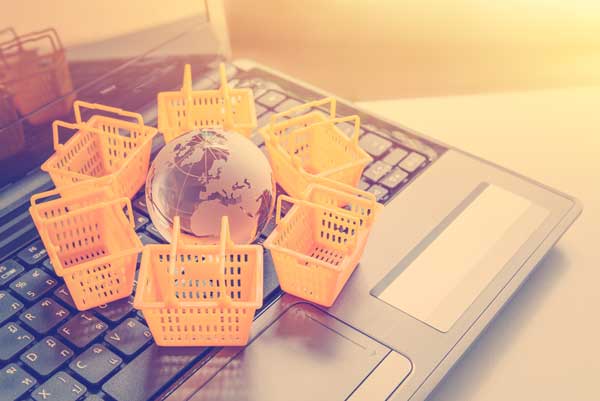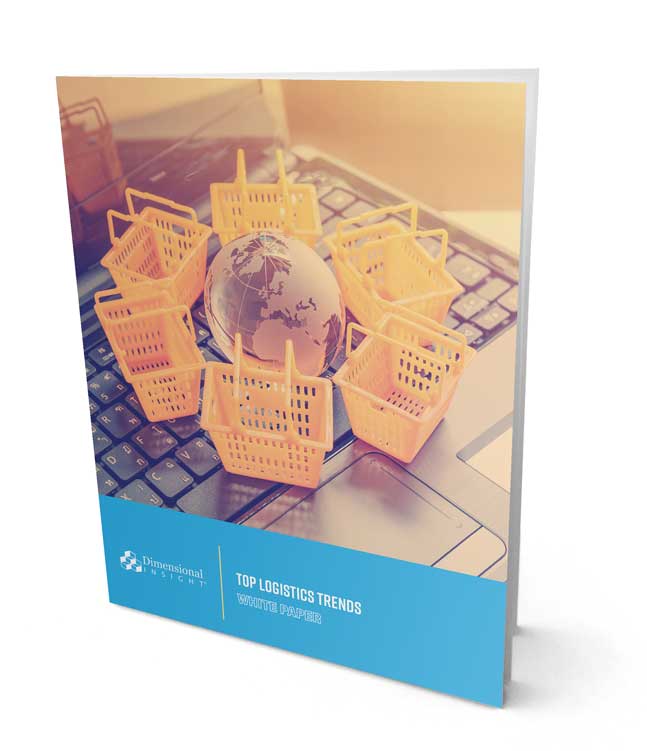
Top Logistics Trends

Top Logistics Trends
The supply chain has seen a lot of turbulence over the last couple of years, with fluctuating shortages and inventory gluts. Logistics companies have learned many lessons from the recent bumps in the road and are working to implement new technologies and strategies to better prepare themselves for the years ahead.
In this white paper, we lay out some of the biggest trends in the logistics industry. These trends include:
Increased automation
New applications for artificial intelligence
Increased sustainability initiatives
Optimized last-mile delivery
Cloud-based solutions
Increased Automation
The stabilization of e-commerce following the fluctuations caused by the pandemic is driving an increase in warehouse construction, and along with that comes an increased demand for automation tools. More than a quarter of warehouses are expected to include some kind of automation by 2027, compared to just 18% at the end of 2021 .But warehouses are not the only area where automation is expected to make an impact. With driver shortages threatening the future of supply chains, logistics companies are investing more and more in the potential of autonomous vehicles. These companies, such as DHL and UPS, hope that autonomous vehicles will help reduce costs and improve efficiency by eliminating some of the obstacles associated with human labor. According to the Global Automated Guided Vehicle (AGV) Market report, the automated guided vehicles segment is expected to grow by $1.15 billion during 2021-2025.
Autonomous trucks have already begun testing on our roads under “supervised autonomy” from companies like Amazon, TuSimple, and Tesla. If properly designed and implemented, these vehicles have the potential to be safer, cheaper, and more reliable than manually driven vehicles.
Automated air delivery has also been receiving substantial attention from investors. Amazon, Google, and UPS have all received approval from the Federal Aviation Administration to begin rolling out their drone-delivery fleets. While more testing is necessary before these vehicles can be deployed at scale, companies are boasting that drone-facilitated deliveries could reduce delivery time to as little as 30 minutes.
New applications for artificial intelligence
The supply chain’s reliance on strict deadlines, optimized cargo holds, and streamlined scheduling makes it an ideal target for new applications of artificial intelligence. At the end of the day, computers are simply far more efficient than humans.
With supply chains still suffering from the consequences of the pandemic, logistics companies are placing increased emphasis on getting as many goods across national and international networks as quickly as possible. With AI-powered route optimization, businesses can better compensate for factors such as weather and traffic patterns. Additionally, AI can be used to make more accurate predictions about the status of a vehicle, improving fuel allocation, and scheduling maintenance.
As the global supply chain grows in complexity, the margin for error is rapidly shrinking. Businesses can’t afford missed deadlines amidst growing competition and customer expectations. AI can help mitigate some of these risks by scheduling deliveries that reflect a company’s inventory while also cutting down on some of the operational bottlenecks experienced within business supply-chains. Furthermore, AI can analyze massive data sets to provide real-time forecasting on supply and demand.
Increased sustainability initiatives
With the amount of goods transported each day, it may come as no surprise that just eight global supply chains are responsible for more than 50% of global carbon emissions. To be more specific, the food, construction, fashion, fast-moving consumer goods, electronics, automotive, professional services, and freight industries are to be blamed. Unfortunately, without effective intervention, those emissions are projected to grow, with a recent study finding that by 2030, delivery-related carbon emissions are set to increase by 30% amidst surges in e-commerce.
Thankfully, not all hope is lost. With growing pressure from consumers for more environmentally friendly practices and increasingly strict regulatory requirements, retailers are starting to take steps to not only reduce carbon emissions, but also track, measure, and report on emissions reduction. Furthermore, the CO2 impact of primary products and purchased parts is becoming increasingly relevant in the supplier selection process, forcing companies to adjust their practices in order to remain competitive.
Moving forward, we are likely to see more and more companies investing in green objectives such as:
- Better route optimization for last-mile logistics
- Environmentally friendly packaging for products
- Micro-fulfillment centers to prepare orders
- Zero-emissions fleets
- Automated storage and retrieval systems
Optimized last-mile delivery
Even prior to the onset of COVID-19, online shopping was on the rise. E-commerce sales are now expected to reach over $5 trillion in 2023. With that rise has also come an increase in demand for cheap and fast delivery options, putting a ton of pressure on logistics service providers.
Last-mile delivery refers to the last portion of the supply chain, in which goods are delivered from the warehouses and distribution centers to the end consumer. This is often the most expensive part of the delivery process for retailers. In 2020, the last-mile delivery market was valued at $18.7 billion, and is expected to reach $62.7 billion by the end of 2027.
As e-commerce continues to grow, companies are investing more in long-term solutions to last-mile delivery like increasing the number of warehouses, advancing delivery methods, improving carbon emissions, and turning to AI-powered routing and scheduling.
Additionally, in this new age of convenience, consumers demand increased transparency and visibility into the delivery of their product. They want to know where their product is and when it’s arriving. With current technology, delivery companies now have the ability to make their supply chain visible to all parties involved, improving brand-consumer relationships and establishing accountability.
Transition to cloud-based solutions
With technology advancing at such an aggressive pace, logistics companies are rapidly transitioning to cloud-based platforms for everything from communication to managing their finances.
With these new solutions, companies are able to streamline their workflows, transfer information quicker and more securely, manage daily actions, and connect with clients and other third-party contractors on a unified online hub. Outside of the increased revenue that comes with more streamlined operations, businesses can also eliminate many of the costs associated with hardware maintenance.
Compared to traditional technologies, cloud computing also has the added benefit of being easily accessible anywhere and at any time. This, coupled with easy scalability, makes it easier for users to focus on running their businesses instead of addressing hiccups in their back-office management.
The Role of Analytics in Logistics Trends
Success in the logistics industry depends on maximizing efficiency in everything from meeting strict deadlines to maximizing your shipping capacity. In short, you need to get as many goods as possible to where they’re going, as fast as possible. But how exactly do you accomplish this?
The key lies in your data. By providing key insights into your company’s operations, data analytics allows you to:
- Identify improvement opportunities
- Track real-time data across your fleet
- Optimize transport routes
- Manage warehouse inventories
- Review supplier and subcontractor performance
- Forecast for the future
- Comply with legislation through mandatory reporting
End-to-end analytics gives logistics companies the edge they need that human labor simply can’t. Up-to-date information, automated reporting, encryption, and system-wide interoperability are just too critical in an industry where businesses can’t risk delays or bottlenecks.
But how do you choose the right platform for your business? Not all platforms are equal in the tools and resources they provide. Determining which platform is best for your organization comes down to what your long-term goals are and how you intend to reach them.
Why Dimensional Insight?
Time and time again, we’ve been ranked as industry leader in user surveys for customer experience. This is because our number 1 priority has always been our customers and what they need to succeed.
We work with our customers to understand their strategic goals, and then work collaboratively to meet those goals.
Additionally, we have optimized our technology to provide unparalleled speed, integration, flexibility, and governance.
We provide a truly end-to-end platform in which we utilize 100% of our own technology. This means each part is optimized to work perfectly with the rest of the platform. Other vendors often cobble together technology from different third parties, which leads to degraded performance and sloppy workarounds.
With Dimensional Insight, you gain real-time speed, seamless integration, the flexibility to view data the way you want to see it, and the governance that provides a single source of truth for your organization.
Interested in learning more?
Send an email to [email protected]
Download white paper:
Top Logistics Trends







